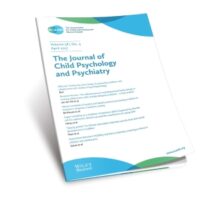Anatomy
-

Neuroanatomical Variability and Early Substance Use Initiation: Insights from the ABCD Study
Adolescence is a period of rapid brain development, making it a sensitive window for experiences that may shape long-term outcomes. A new study from the Adolescent Brain Cognitive Development (ABCD) project examined whether neuroanatomical variability is linked to early initiation of alcohol, nicotine, or cannabis. Drawing on baseline brain images taken before substance use began, the researchers found regionally specific differences in cortical thickness and surface area among early initiators. The findings highlight the complexity of adolescent neurodevelopment and point to the value of large-scale, longitudinal studies in clarifying how brain structure and behaviour unfold together.
Read more -

DNA Methylation, Lateral Ventricular Volume, and Psychiatric Risk for Schizophrenia
In this Papers Podcast, Dr. Charlotte Cecil and Dr. Mannan Luo discusses their co-authored JCPP paper ‘DNA methylation at birth and lateral ventricular volume in childhood: a neuroimaging epigenetics study’.
Read more -

Interplay of early negative life events, development of orbitofrontal cortical thickness and depression in young adulthood
Open Access paper from JCPP Advances – ‘Using a complete longitudinal design with four time points, we examined whether NLE during childhood and early adolescence predict depressive symptoms in young adulthood through accelerated OFC thinning across adolescence.’ Lea L. Backhausen (pic) and Jonas Granzow et al.
Read more -

Transdiagnostic Profiles of Behaviour and Communication: Academic and Socioemotional Functioning and Neural White Matter Organisation
In this Papers Podcast, Dr. Silvana Mareva discusses her JCPP paper ‘Transdiagnostic profiles of behaviour and communication relate to academic and socioemotional functioning and neural white matter organisation’. Silvana is the first author of the paper.
Read more -

Brain grey and white matter structural associations with future suicidal ideation and behaviors in adolescent and young adult females with mood disorders
Open Access from JCPP Advances – “To reduce suicide in females with mood disorders, it is critical to understand brain substrates underlying their vulnerability to future suicidal ideation and behaviors (SIBs) in adolescence and young adulthood”. Lejla Colic et al.
Read more -

Attention-deficit/hyperactivity disorder and white matter microstructure: The importance of dimensional analyses and sex differences
Open Access paper from JCPP Advances – “Attention-deficit/hyperactive disorder (ADHD) has substantial heterogeneity in clinical presentation. A potentially important clue may be variation in brain microstructure. Using fractional anisotropy (FA), previous studies have produced equivocal results in relation to ADHD. This may be due to insufficient consideration of possible sex differences and ADHD’s multi-componential nature”. Scott A. Jones et al.
Read more -

Multivariate associations between behavioural dimensions and white matter across children and adolescents with and without attention-deficit/hyperactivity disorder
Open Access paper from the JCPP – “This study aimed to identify associations between white matter and a broad set of clinical features across children and adolescent with and without ADHD using a data-driven multivariate approach”. Xuan Bu et al.
Read more -

Progressive cortical thinning might identify children at risk of developing psychotic spectrum symptoms
Offspring of patients with schizophrenia or bipolar disorder have an increased risk of developing these conditions. However, our capacity to predict the long-term outcomes of these at-risk individuals is limited. Now, researchers have investigated whether longitudinal changes in brain structure differ in individuals at high familial risk who develop psychotic spectrum symptoms, compared to those who do not and to low-risk controls.
Read more -

Emotional abuse during childhood is linked with differences in brain structure
Delia Gheorghe and colleagues at the University of Oxford have harnessed data from the UK Biobank to delineate the relationship between adverse experiences and brain structure. The researchers accessed brain imaging data together with retrospective reports of childhood adversity and adulthood partner abuse from more than 6,000 adults (mean age, 62.1 years).
Read more -

Do brain function abnormalities lead to substance use, or vice versa?
New research has, for the first time, investigated the direction of links between brain function and substance use throughout adolescence. Jungmeen Kim-Spoon and colleagues studied 167 adolescents who were assessed annually for four years from 13-14 years old.
Read more